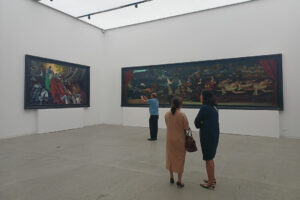IN THE 1870s, Filipino painter Juan Luna traveled to Europe, where he studied painting and became engrossed in the arts. Aside from attending exhibitions (where some of his own works were shown), he also liked to watch theater and ballet, ultimately basking in how conducive it was to creatively express.
For Randalf Dilla, a Filipino painter living in the 21st century, the feeling was similar when he moved from his home province of Batanes to Metro Manila to study art. He went to visit many museums and found inspiration in the works of the old Filipino masters, including Luna.
In his latest exhibit, “Time Tunnel,” on view at the Metropolitan Museum of Manila (The M), Mr. Dilla pays tribute to three of the great artworks that influenced him — Fabian Dela Rosa’s Kundiman from 1932, Fernando Amorsolo’s Planting Rice from 1924, and Juan Luna’s En El Palco from 1884.
The first piece he did was Theater Show in 2021, inspired by the Luna painting.
“These three are works commissioned by [avid art patron collector] Paulino Que. When I completed the Luna tribute, he asked for works on Amorsolo and Dela Rosa,” Mr. Dilla told reporters at the exhibit launch. “We had no idea then that it would be[come] an exhibition.”
Theater Show is a massive piece, both in scale and concept, feeling like a fast-paced journey into the past as it depicts Luna in the foreground carrying his painting and standing by a steel train that hurtles past. The eye naturally travels given the great sense of movement in every element of the work. From the birds flying in the opposite direction of the train where a man lets go of papers out the window, to the garishly dressed bailarinas and cantantes in an exhilarating rush, the painting evokes an epic journey. In the background, an audience watches the scene unfold from a vast indoor theater.
It’s no surprise that renowned Filipino historian Ambeth Ocampo, who curated the show, named the exhibition “Time Tunnel,” taken from the 1960s television program of the same name, where lost scientists travel back and forth in time.
In the foreword of an accompanying limited-edition catalog that can be purchased at the Met Museum, Mr. Ocampo writes that Mr. Dilla’s imagined histories depict the old masters, their works, and the actual spaces they inhabited as “visions conjured up in his mind’s eye.”
For Mr. Dilla, this topic was always alluring. Years back, after graduating from college, he participated in an exhibition paying tribute to Amorsolo. But it was only during the pandemic that he was able to expand on his homage further.
Reminiscences, completed in 2022, shows how he studied and explored the deeper meaning behind Amorsolo’s Planting Rice. To him, it was essential that modern-day Filipinos emotionally connect with it.
“May vibes talaga na nanunumbalik kasi nakikita mo iyung mga magsasaka na nandito sa makabagong setting (Here, there are nostalgic vibes since you can see the farmers blending into the modern setting),” Mr. Dilla said.
The painting depicts the landscape of fields with farmers shown in Planting Rice on the left fading into a gallery filled with other Amorsolos. Connecting the two is a carabao pulling a cart that then morphs into a steel vehicle of more modern times.
At The M, one can find the original paintings by the old masters and Mr. Dilla’s new works exhibited in the same hall. Because Reminiscences hangs near its inspiration, you can literally look back in time.
Finally, Old Culture, painted in 2023, based on Fabian Dela Rosa’s Kundiman from 1932, provides a great example of “research as an important part of the process,” according to Mr. Dilla.
It recalls the tradition of suitors serenading the object of their affection, widely practiced long ago. It shows an old Filipino home where a crowd of men sing and try to reach up to the women who appear to be rising up towards the ceiling that opens up towards the heavens.
For his research, Mr. Dilla went to the home of Dr. Luis Santos, the man who commissioned and owned Kundiman.
“That’s the house I used in the painting, but the house was worn down like all the others on that street that are being demolished one by one,” he said in the vernacular, explaining why he painted the house opening up to the skies.
Just like the pre-war Manila homes, he wanted to show that the courtship tradition of the harana and the popularity of kundiman are dying out.
An interesting detail to note is that Mr. Dilla’s wife was the model for the lady being courted and he himself the model for the men singing to her.
In his foreword, Mr. Ocampo emphasizes that “past, present, and future, the surreal and the hyperreal, the physical and the metaphysical all collide and lose themselves in this exhibition.”
To explore the nature of the past and its relationship with the present, view “Time Tunnel” at The M in Bonifacio Global City. The exhibit runs until Oct. 28. Pre-registration through bit.ly/MVisit is required at least a day before visiting the museum. — Brontë H. Lacsamana
